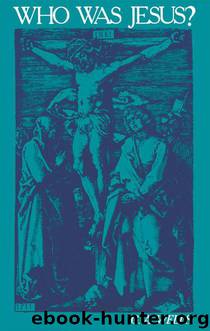Who was Jesus?: A Critique of the New Testament Record by Wells George Albert

Author:Wells, George Albert [Wells, George Albert]
Language: eng
Format: mobi, epub
ISBN: 9780812698688
Publisher: Open Court
Published: 2013-11-30T16:00:00+00:00
c. Activity in Jerusalem
Mark follows Jesus’s triumphal entry into Jerusalem with his cursing of a fig tree for not supplying him with figs, even though “it was not the season for figs” (11:13). Was Jesus a child who would kick an object that offended him? For Haenchen (p. 382), the story is of interest as illustrating that even the gospel passion narratives are not lacking legendary features. A little later, Mark reports that the next day the tree was seen to be withered (11:20–24), and this gives occasion for Jesus to laud faith, saying that it can even move mountains. At 1 Corinthians 13:2 Paul mentions faith sufficient to remove mountains, but does not suggest that Jesus ever spoke on such lines. But faith was so important to early Christianity that it will have been natural to invent a story in which he inculcates it. The occasion for the legend may have been some prominent withered fig tree near Jerusalem which invited an account of how it came to be in this state. If the story was not originally set at Passover, the words “it was not the season for figs” will not have formed part of it. But as Mark makes Jesus come to Jerusalem on one occasion only, and at Passover, he will have seen fit to add them.
In between the cursing of the tree and the report of its having withered Mark places Jesus’s so-called cleansing of the temple, on which I have commented elsewhere.6 Luke did not much like this act of violence and at 19:45 deleted Mark’s statements (11:15–16) that Jesus “overthrew the tables of the moneychangers, and the seats of them that sold the doves; and he would not suffer that any man should carry a vessel through the temple”. Luke’s Jesus is here said only to have “cast out them that sold” (not, as in Mark, both “them that sold and them that bought in the temple”). According to Mark 11:18 it was this event which made “the chief priests and the scribes” seek “how they might destroy him”. Luke, having all but eliminated Jesus’s violence, attributes their hostility to dislike of his teaching. In the fourth gospel the whole incident is placed at the beginning of his ministry (2:13–22) and has no outward consequences.
In Mark’s next incident after Jesus’s words about faith he is “walking in the temple” (11:27)—the day after his violent behaviour in it. If it is difficult to believe that the temple authorities permitted such violence, it is even harder to accept that they would have allowed the perpetrator to walk unimpeded in the temple area so soon afterwards. The incident introduced in this way may, then, like so many others in Mark (cf. above, p. 12), represent a tradition that was independent of the setting here given to it. It consists of a challenge from the “chief priests and the scribes and the elders” in the form of the question: “By what authority doest thou these things?” ‘These things’ cannot refer to his walking about in the temple.
Download
Who was Jesus?: A Critique of the New Testament Record by Wells George Albert.epub
This site does not store any files on its server. We only index and link to content provided by other sites. Please contact the content providers to delete copyright contents if any and email us, we'll remove relevant links or contents immediately.
| Exegesis & Hermeneutics | New Testament |
| Old Testament |
The Five People You Meet in Heaven by Mitch Albom(3474)
The Secret Power of Speaking God's Word by Joyce Meyer(2968)
Real Sex by Lauren F. Winner(2966)
Name Book, The: Over 10,000 Names--Their Meanings, Origins, and Spiritual Significance by Astoria Dorothy(2938)
The Holy Spirit by Billy Graham(2892)
0041152001443424520 .pdf by Unknown(2783)
ESV Study Bible by Crossway(2732)
How The Mind Works by Steven Pinker(2729)
Ancient Worlds by Michael Scott(2622)
Churchill by Paul Johnson(2505)
The Meaning of the Library by unknow(2503)
The ESV Study Bible by Crossway Bibles(2502)
The Gnostic Gospels by Pagels Elaine(2468)
MOSES THE EGYPTIAN by Jan Assmann(2372)
Jesus by Paul Johnson(2309)
City of Stairs by Robert Jackson Bennett(2307)
The Complete Dead Sea Scrolls in English (7th Edition) (Penguin Classics) by Geza Vermes(2231)
Ancient Near Eastern Thought and the Old Testament by John H. Walton(2194)
The Nativity by Geza Vermes(2178)
